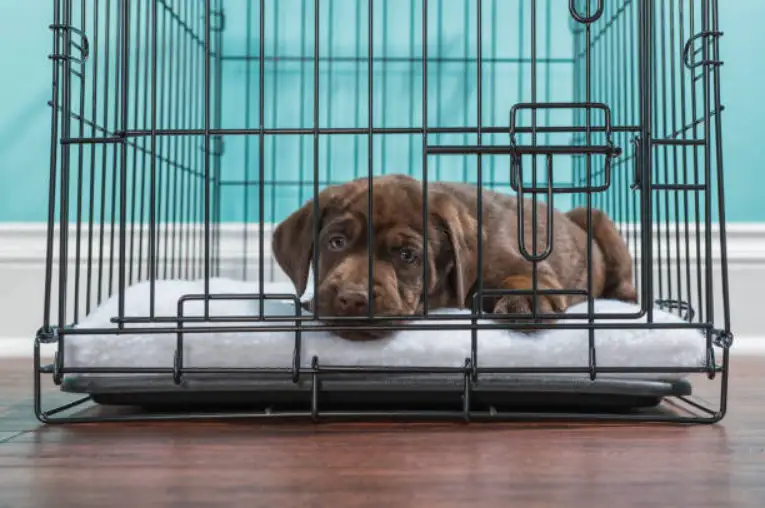Is it bad to crate my dog in another room at night? Expert Advice
As a dog owner, providing your furry friend with a safe and comfortable space to sleep is essential. Crate training is a popular method for achieving this, but many owners have concerns about crating their dog in another room at night. This article will explore the pros and cons of crate training, why crating in another room may not be harmful, alternatives to crating, and tips for successful crate training.
Is it bad to crate my dog in another room at night? No. Many dogs feel secure in their crate, and it can help with potty training and preventing destructive behavior when left alone.

Table of Contents
- Introduction to Crate Training
- Pros and Cons of Crate Training
- Why Crating in Another Room May Not Be a Bad Thing
- Addressing Concerns About Crating in Another Room
- Alternatives to Crating in Another Room at Night
- Tips for Making Crate Training Successful
- Common Mistakes to Avoid When Crate Training
- Understanding Your Dog’s Behavior and Needs
- Conclusion
- FAQ
Introduction to Crate Training
Crate training involves using a crate as a safe and comfortable space for your dog to sleep, eat, and relax. The crate should be large enough for your dog to stand up, turn around, and lie comfortably.
However, some people hesitate to crate-train their dog, fearing it may be cruel or uncomfortable for their pet. It is important to note that when done correctly, crate training can be a positive experience for both you and your dog.
Pros and Cons of Crate Training
There are several benefits to crate training your dog. It can help with potty training by teaching your dog to hold their bladder and bowel movements until they are outside. Crating can also prevent destructive behavior such as chewing or scratching on furniture.
Additionally, it can provide your dog with a safe and secure space to retreat when they feel anxious or overwhelmed.
However, there are also some potential drawbacks to crate training. If not done correctly, your dog may develop negative associations with the crate, such as feeling trapped or isolated.
Additionally, some dogs may feel anxious or fearful when crated, which can lead to whining, barking, or attempts to escape.
Why Crating in Another Room May Not Be a Bad Thing
Many dog owners assume that crating their dog in another room at night is terrible, but this is not necessarily the case. Crating in another room can have several benefits.

First, it can help your dog sleep better. If your dog is easily distracted by noise or movement, sleeping in another room can provide a quieter and more peaceful environment for them to rest.
Additionally, if you have other pets or children in the home, crating your dog in another room can prevent them from disturbing each other during the night.
It is important to note that if you choose to crate your dog in another room, you should still ensure that they have access to water and are able to go outside if needed.
Addressing Concerns About Crating in Another Room
If you have concerns about crating your dog in another room, there are several things you can do to address them.
First, make sure that your dog is comfortable and familiar with their crate. This can be achieved by gradually introducing them to the crate and providing positive reinforcement such as treats and praise.
Additionally, consider using a baby monitor or other device to monitor your dog while they are crated in another room. This can provide reassurance that your dog is safe and comfortable and can alert you if they are in distress.
Alternatives to Crating in Another Room at Night
If you are not comfortable with crating your dog in another room at night, there are several alternatives you can try.
One option is to provide your dog with a comfortable bed or blanket in your bedroom. This can give them a sense of security and closeness to their owners while allowing them to have their own space.
Another option is to use a playpen or gated area to confine your dog at night. This can provide them with more space to move around and play while still keeping them contained and safe.
Tips for Making Crate Training Successful
If you decide to crate train your dog, there are several tips you can follow to make the experience as positive as possible.
First, make sure that your dog is comfortable and familiar with their crate. Gradually introduce them to the crate, and provide positive reinforcement, such as treats and praise, when they enter or spend time in the crate.
Additionally, never use the crate as a form of punishment. Your dog should associate the crate with positive experiences such as treats and relaxation.
Finally, make sure that your dog has plenty of opportunities for exercise and playtime outside of the crate. This can prevent boredom and restlessness and make crate training more successful overall.
Common Mistakes to Avoid When Crate Training

There are several common mistakes that owners make when crate-training their dogs.
These include,
- Using the crate as a form of punishment
- Leaving the dog in the crate for too long
- Not providing enough positive reinforcement for using the crate
- Introducing the crate too quickly or abruptly
- Not providing enough exercise and playtime outside of the crate
By avoiding these mistakes and following the tips outlined above, you can help ensure your dog’s crate training experience is positive and successful.
Understanding Your Dog’s Behavior and Needs
It is important to remember that every dog is different, and what works for one dog may not work for another. Understanding your dog’s behavior and needs can help you make the best decisions for their well-being.
If you are unsure about whether or not crating in another room is the right choice for your dog, consider consulting with a veterinarian or professional dog trainer. They can provide personalized advice and guidance based on your dog’s needs and behavior.
Will My Dog Come Back If I Let Him Outside? [5 Tips to train]
puppiesdiary.com
Conclusion
In conclusion, crating your dog in another room at night may not be wrong, provided it is done correctly and with your dog’s comfort and safety in mind. Crating can provide your dog with a safe and secure space to sleep and relax and can help with potty training and preventing destructive behavior.
However, it is essential to consider your dog’s needs and behavior and avoid common mistakes such as using the crate as punishment or leaving it in the crate for too long.
Following the tips and advice outlined in this article can help ensure your dog’s crate training experience is positive and successful.
Related Articles: –
https://www.puppiesdiary.com/punch-a-dog-when-that-dog-tries-to-bite-me/
Is It Bad That I Can Feel My Dog’s Microchip? [Vet Conclusion]
FAQ
Is crating my dog in another room at night cruel?
When done correctly, crating your dog in another room at night is not cruel. It can provide your dog a safe and secure space to sleep and relax.
How long can I leave my dog crated at night?
It is generally recommended that you do not leave your dog crated for longer than 4-6 hours at a time.
What if my dog doesn’t like their crate?
If your dog is resistant to their crate, try gradually introducing them to it and providing positive reinforcement such as treats and praise. Consider consulting with a professional dog trainer for personalized advice and guidance.
Can I crate my dog during the day as well as at night?
While it is generally not recommended to crate your dog for extended periods during the day, short crating can be beneficial for potty training and preventing destructive behavior. Be sure to provide your dog with plenty of exercise and playtime outside the crate.


![Facts Of Earthdog Breeds Training, Trails And Test [Expert Advice] 5 Facts Of Earthdog Breeds Training, Trails And Test [Expert Advice]](https://www.puppiesdiary.com/wp-content/uploads/2023/11/Earthdog-Breeds-Training-768x505.jpg)



